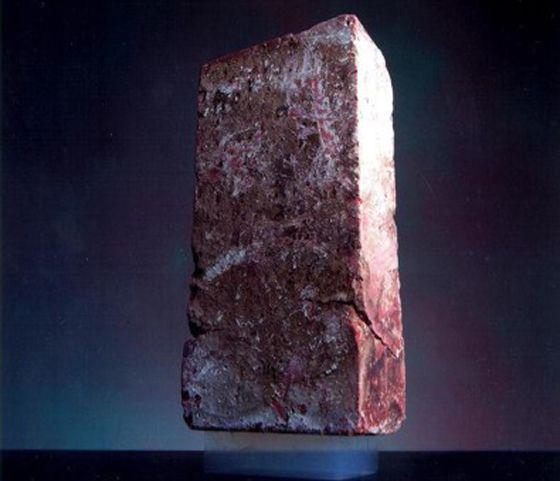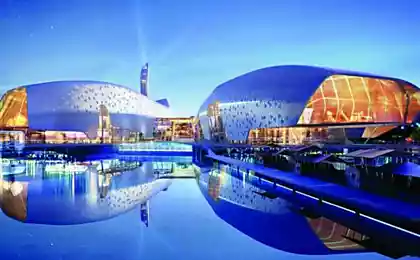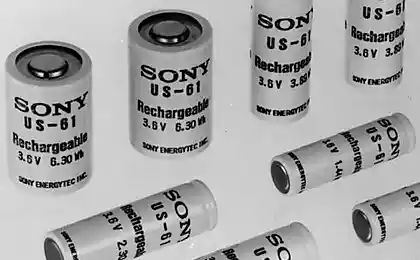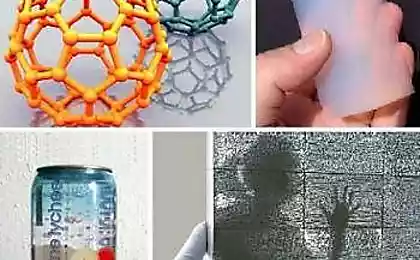1366
Materials of the Future
What are the materials of the future? Today, it is being developed and developing materials, which people of the past could only dream of. They are cheaper, stronger, better, better in all respects. Applications it will be a huge amount. Let's turn the page now and get acquainted with the materials that can actually invert your perception of metals and other materials.

1. Aerogel

This tiny unit supports transparent airgel bricks weighing 2 to 5 kg. The density of airgel - 3 mg / cc.
Aerogel allotted 15 positions in the Guinness Book of Records - more than any other material. Sometimes called "frozen smoke" airgel produced during supercritical drying liquid gel of aluminum, chromium, tin oxide, or carbon. At 99, 8% airgel consists of an empty space, which makes it translucent. Aerogel insulates fantastic - if you have a shield of airgel, it will protect you from the flow of heat. And also to protect from the cold. From it we could build a warm dome on the Moon. In aerogels incredible surface area of internal fractal structure - a cube of airgel with the face of an inch has an internal area equivalent to a football field. Despite the low density airgel is considered as a component of military armor because of its insulating properties.

2. Carbon nanotubes
Carbon nanotubes - are long chains of carbon held strong ties throughout chemistry, sp2, which is even stronger than the sp3, holding the diamond. Carbon nanotubes have many excellent properties in terms of physics, easily conduct electrons, and so strong that it is the only substance in the theory suitable for the construction of a space elevator. The specific strength of carbon nanotubes - 48 000 kNm / kg, a strength can not boast even high-carbon steel (154 kNm / kg). The three hundred times stronger than steel. From such material can build towers hundreds kilometers high.

3. Metamaterials
"Metamaterials" could be called any material that gains its properties from structure rather than composition. Metamaterials used to create microwave invisibility cloaks, two-dimensional invisibility cloaks and materials with unusual optical properties. Some metamaterials have a negative index of refraction, the optical quantity which allows the creation of "superlensing" through which can be seen the elements that are smaller than the wavelength of light. This technology is called subwavelength imaging. Metamaterials are planning to use to create the perfect holograms 2D-displays. They would be so perfect that if you looked at the screen from a distance of 10 centimeters, even be determined that a hologram.

4. Available diamonds
We have long been used thick layers of diamonds in different machines, thereby bringing a time when diamonds are used everywhere. Diamond - the ideal building material. It is durable, lightweight, made from readily available carbon is almost completely heat conductor and has one of the highest melting point and boiling point of all the materials. Introducing the trace, you can make almost any color diamond. Imagine fighter engine which hundreds of thousands of moving parts made of diamond. Such a device would be many times more powerful than the best aircraft today.

5. Available fullerenes
Diamonds are durable, but aggregated diamond nanorods (so-called amorphous fullerenes) stronger. Nanoscale structure of fullerenes give them a beautiful iridescent look. Fullerenes may be substantially stronger than diamond, but their manufacture requires more energy. After the "Diamond Age" we may get to the "age of fullerenes", and our technology will be more complex.

6. Amorphous metals
Amorphous metals also known as metallic glasses, are composed of a metal with a disordered atomic structure. They can be twice as strong as steel. Because disordered structure may dissipate impact energy more efficiently than the metal crystals which have weaknesses. Amorphous metals are created during the rapid cooling of the molten metal before it will form a crystal lattice. Amorphous metals may become the next generation of military armor before diamondoid materials will be replaced by mid-century. If we talk about the environment, amorphous metals have electronic properties that a 40% increase the efficiency of power grids, saving us thousands of tonnes of emissions of fossil fuels.

7. superalloy
Superalloy - a general term for a metal which can operate at very high temperatures (1100 ° C). They were happy to use in areas of superhot turbine jet engines. They are also used in more complicated designs. When we fly through the sky in a hypersonic aircraft, we have to thank the superalloy.

8. The metal foam
Metal foam - this is what you get when you add a foaming agent, titanium hydride powder, the molten aluminum, and then give it to cool. The result is an extremely durable substance that is relatively easy, with 75-95% empty space. Due to its favorable ratio of strength to weight of metal foams have been proposed as a building material for space colonies. Some forms of the metal foam is so light that float on the water, which makes them an excellent tool for the construction of a floating city.

9. Transparent aluminum
Transparent aluminum is three times stronger than steel and transparent. The number of applications of this material is truly enormous. Imagine a skyscraper or arcology consisting of transparent steel. Horizons of the future may look like a series of floating black spots (separate rooms), and not monoliths, like today. A huge space station, made of transparent aluminum oxide will float above the Earth is not a terrible black dot, and the invisible companion. How about transparent swords?

10. E-cloth
When we meet over a cup of coffee in 2020, I'll probably wearing an electronic clothes. Why carry electronic gadgets that are easy to lose, if you can just carry around computers? Currently under development of alternative methods of carrying computers, and if in the near future we will see perhaps that sunglasses and watches soon schemes will be sewn directly into what we wear. After all, great to talk to someone on the phone, just raise your hand to your ear. Features electronic clothes truly endless.

Source: hi-news.ru

1. Aerogel

This tiny unit supports transparent airgel bricks weighing 2 to 5 kg. The density of airgel - 3 mg / cc.
Aerogel allotted 15 positions in the Guinness Book of Records - more than any other material. Sometimes called "frozen smoke" airgel produced during supercritical drying liquid gel of aluminum, chromium, tin oxide, or carbon. At 99, 8% airgel consists of an empty space, which makes it translucent. Aerogel insulates fantastic - if you have a shield of airgel, it will protect you from the flow of heat. And also to protect from the cold. From it we could build a warm dome on the Moon. In aerogels incredible surface area of internal fractal structure - a cube of airgel with the face of an inch has an internal area equivalent to a football field. Despite the low density airgel is considered as a component of military armor because of its insulating properties.

2. Carbon nanotubes
Carbon nanotubes - are long chains of carbon held strong ties throughout chemistry, sp2, which is even stronger than the sp3, holding the diamond. Carbon nanotubes have many excellent properties in terms of physics, easily conduct electrons, and so strong that it is the only substance in the theory suitable for the construction of a space elevator. The specific strength of carbon nanotubes - 48 000 kNm / kg, a strength can not boast even high-carbon steel (154 kNm / kg). The three hundred times stronger than steel. From such material can build towers hundreds kilometers high.

3. Metamaterials
"Metamaterials" could be called any material that gains its properties from structure rather than composition. Metamaterials used to create microwave invisibility cloaks, two-dimensional invisibility cloaks and materials with unusual optical properties. Some metamaterials have a negative index of refraction, the optical quantity which allows the creation of "superlensing" through which can be seen the elements that are smaller than the wavelength of light. This technology is called subwavelength imaging. Metamaterials are planning to use to create the perfect holograms 2D-displays. They would be so perfect that if you looked at the screen from a distance of 10 centimeters, even be determined that a hologram.

4. Available diamonds
We have long been used thick layers of diamonds in different machines, thereby bringing a time when diamonds are used everywhere. Diamond - the ideal building material. It is durable, lightweight, made from readily available carbon is almost completely heat conductor and has one of the highest melting point and boiling point of all the materials. Introducing the trace, you can make almost any color diamond. Imagine fighter engine which hundreds of thousands of moving parts made of diamond. Such a device would be many times more powerful than the best aircraft today.

5. Available fullerenes
Diamonds are durable, but aggregated diamond nanorods (so-called amorphous fullerenes) stronger. Nanoscale structure of fullerenes give them a beautiful iridescent look. Fullerenes may be substantially stronger than diamond, but their manufacture requires more energy. After the "Diamond Age" we may get to the "age of fullerenes", and our technology will be more complex.

6. Amorphous metals
Amorphous metals also known as metallic glasses, are composed of a metal with a disordered atomic structure. They can be twice as strong as steel. Because disordered structure may dissipate impact energy more efficiently than the metal crystals which have weaknesses. Amorphous metals are created during the rapid cooling of the molten metal before it will form a crystal lattice. Amorphous metals may become the next generation of military armor before diamondoid materials will be replaced by mid-century. If we talk about the environment, amorphous metals have electronic properties that a 40% increase the efficiency of power grids, saving us thousands of tonnes of emissions of fossil fuels.

7. superalloy
Superalloy - a general term for a metal which can operate at very high temperatures (1100 ° C). They were happy to use in areas of superhot turbine jet engines. They are also used in more complicated designs. When we fly through the sky in a hypersonic aircraft, we have to thank the superalloy.

8. The metal foam
Metal foam - this is what you get when you add a foaming agent, titanium hydride powder, the molten aluminum, and then give it to cool. The result is an extremely durable substance that is relatively easy, with 75-95% empty space. Due to its favorable ratio of strength to weight of metal foams have been proposed as a building material for space colonies. Some forms of the metal foam is so light that float on the water, which makes them an excellent tool for the construction of a floating city.

9. Transparent aluminum
Transparent aluminum is three times stronger than steel and transparent. The number of applications of this material is truly enormous. Imagine a skyscraper or arcology consisting of transparent steel. Horizons of the future may look like a series of floating black spots (separate rooms), and not monoliths, like today. A huge space station, made of transparent aluminum oxide will float above the Earth is not a terrible black dot, and the invisible companion. How about transparent swords?

10. E-cloth
When we meet over a cup of coffee in 2020, I'll probably wearing an electronic clothes. Why carry electronic gadgets that are easy to lose, if you can just carry around computers? Currently under development of alternative methods of carrying computers, and if in the near future we will see perhaps that sunglasses and watches soon schemes will be sewn directly into what we wear. After all, great to talk to someone on the phone, just raise your hand to your ear. Features electronic clothes truly endless.

Source: hi-news.ru
























